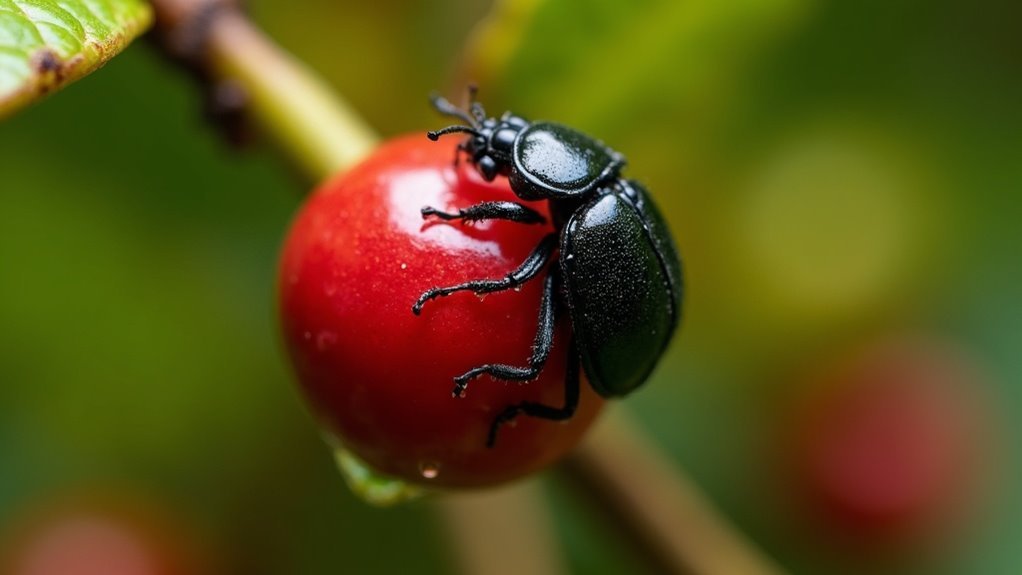The Coffee Berry Borer (CBB), or Hypothenemus hampei, is a tiny pest measuring 1.2 to 1.8 mm. It infests coffee berries, reproducing rapidly with females laying 35-50 eggs shortly after entry. CBB thrives in warm, humid environments, causing yield losses of 30-35% and degrading coffee quality. This pest is found in nearly all coffee-producing regions worldwide, threatening the livelihoods of millions of coffee growers. On this website, you’ll uncover essential management strategies to combat this significant threat to your coffee cultivation.
Key Takeaways
- The Coffee Berry Borer (CBB) is a small beetle, measuring 1.2 to 1.8 mm, that infests coffee berries, posing a serious threat to coffee cultivation.
- CBB reproduces rapidly, with females laying 35-50 eggs shortly after entering coffee berries, leading to swift population increases.
- It thrives in warm, humid environments, with optimal temperatures between 18°C to 25°C and humidity levels of 50% to 90%, conditions often found in coffee-growing regions.
- CBB causes significant damage, leading to yield losses of 30-35% and affecting up to 100% of coffee harvests, making it a critical concern for coffee producers.
- Effective control measures include regular monitoring of coffee plants, removal of fallen berries, pruning to improve air circulation, and utilizing biological control methods to mitigate the impact of CBB on coffee production.
Description and Biology of Coffee Berry Borer
The Coffee Berry Borer (CBB), or Hypothenemus hampei, is a diminutive but formidable pest, measuring between 1.2 to 1.8 mm in length.
This primary coffee seed pest exhibits a unique reproductive strategy, with females laying 35-50 eggs within coffee berries shortly after entry.
CBB thrives in warm, humid environments, optimizing survival between 18°C to 25°C and humidity levels of 50% to 90%.
CBB flourishes in warm, humid conditions, thriving best at temperatures of 18°C to 25°C and humidity of 50% to 90%.
Its life cycle consists of egg, larval, pupal, and adult stages, all occurring within the berry.
Development from egg to adult takes approximately 24 to 45 days, allowing for rapid population growth in coffee-growing regions.
Life Cycle and Reproduction
Understanding the life cycle and reproduction of the coffee berry borer (CBB) is essential for coffee producers, as this pest can rapidly devastate coffee crops.
The CBB undergoes four stages: egg, larva, pupa, and adult, all occurring within coffee seeds. Female CBBs lay 35 to 50 eggs just two days after infesting the seeds, with the entire development cycle from egg to adult taking between 24 to 45 days, depending on environmental conditions.
Female CBBs have a lifespan ranging from 35 to 190 days, while males live for 20 to 87 days. Notably, sibling mating within the seeds leads to a skewed female-to-male ratio of 10:1, which facilitates rapid population growth and allows for multiple generations to thrive on a single coffee tree.
Understanding this life cycle is crucial for effective pest management in coffee cultivation.
Colonization and Distribution
The coffee berry borer‘s geographic spread is alarming, as it has infested nearly all coffee-producing regions except for Nepal and Papua New Guinea.
This pest primarily targets coffee cherries, and its host plant preferences greatly influence its colonization patterns.
Understanding these dynamics is essential for managing its impact on coffee cultivation globally, especially for coffee producers and enthusiasts who are passionate about the quality and sustainability of coffee.
Geographic Spread Patterns
As coffee berry borer (Hypothenemus hampei) continues its relentless spread, its geographic distribution has become a critical concern for coffee-producing nations.
This pest, which originated in central Africa, has invaded most coffee-producing countries since its first detection in Brazil in 1926. By the late 1980s, it reached Colombia after penetrating Guatemala and Mexico in the 1970s.
The 1990s saw its presence in the Dominican Republic, followed by Puerto Rico in 2007 and Hawaii in 2010. Each coffee plant can host multiple generations of this pest, complicating control efforts and threatening the livelihoods of over 20 million families dependent on coffee harvests.
Host Plant Preferences
Coffee berry borer (CBB) exhibits a strong preference for specific host plants, primarily targeting Coffea arabica and Coffea canephora.
Females typically attack coffee cherries between 8 to 32 weeks post-flowering, depending on the maturity of the fruit. Each female lays 35 to 50 eggs in the endosperm of the berries within two days of entry.
CBB infests coffee plants in various countries, with significant populations in Brazil, Guatemala, and Colombia. A single coffee plant can support 3 to 5 generations of CBB, leading to populations that can reach up to 100 beetles per fruit, which severely compromises both the yield and quality of coffee.
Damage Caused by Coffee Berry Borer
Damage from the Coffee Berry Borer (CBB) poses a significant threat to coffee production, leading to substantial economic losses for growers. This pest primarily inflicts damage to coffee berries, resulting in premature fruit drop and a marked decrease in seed quality.
Growers may face yield losses of 30-35%, with infestations potentially affecting up to 100% of the harvest. Infested berries display small holes, deformities, and signs of rot, making them unsuitable for specialty markets. As a result, lower-quality beans, categorized as second-class, lead to reduced market prices and diminished profitability.
Moreover, the increased costs associated with pest control can consume 5-11% of a farm’s income, further compounding these challenges for coffee producers.
Prevention and Control Measures
To effectively combat the Coffee Berry Borer (CBB), implementing a combination of proactive prevention and control measures is essential.
Combating the Coffee Berry Borer requires proactive prevention and effective control measures for successful management.
Consider these strategies:
- Regularly monitor coffee plantations for signs of CBB.
- Remove fallen and immature coffee berries to disrupt the lifecycle of the pest.
- Prune coffee plants post-harvest to minimize breeding grounds for CBB.
- Set baited traps with a 3:1 methanol-ethanol mix in pruned coffee fields.
- Utilize biological control methods, such as parasitic nematodes and Beauveria bassiana, as part of an Integrated Pest Management strategy tailored for coffee cultivation.
Economic Impact and Future Challenges
As global temperatures rise, the economic impact of the Coffee Berry Borer (CBB) intensifies, posing significant challenges for coffee producers worldwide. This pest causes annual damages up to $500 million, threatening the livelihoods of over 20 million families involved in coffee cultivation. Infestations can lead to yield losses of 30-35%, and the costs of pest control consume 5-11% of farm income. With regions warming, the reproduction rates of CBB could increase, exacerbating these challenges. Current pest management strategies may struggle to keep up with the effects of climate change, potentially resulting in higher coffee prices and diminished harvests.
| Impact | Details | Consequences |
|---|---|---|
| Economic Loss | $500 million annually | Reduced livelihoods |
| Yield Reduction | 30-35% losses | Lower coffee supply |
| Pest Control Costs | 5-11% of income | Financial strain |
| Climate Change Effects | Increased CBB reproduction | Greater threat to coffee production |
| Management Ineffectiveness | Current strategies may falter | Rising prices, diminished harvests |








